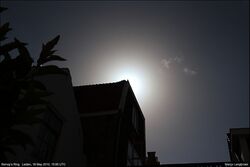Earth:Bishop's Ring

A Bishop's Ring is a diffuse brown or bluish halo observed around the sun. It is typically observed after large volcanic eruptions. The first recorded observation of a Bishop's Ring was by Rev. Sereno Edwards Bishop[1] of Honolulu, after the Krakatoa eruption of August 27, 1883.[2]
This gigantic explosion threw a vast quantity of dust and volatile gases into the atmosphere. Sulfate aerosols remained in the stratosphere, causing colorful sunrises and sunsets for several years. The first observation of this ring was published in 1883, being described as a “faint halo” around the sun. Bishop observed the phenomenon on September 5, 1883; the phenomenon was subsequently named after him, and was the subject of an 1886 professorial dissertation (Habilitationsschrift) by Albert Riggenbach.[3]
Most observations agree that the inner rim of the ring is whitish or bluish white and that its outside is reddish, brownish or purple. The area enclosed by the ring is significantly brighter than its surroundings. From the sequence of colors with the red on the outside one can conclude that the phenomenon is caused by diffraction because halos always have their red part on their inside.[4] On average, the radius of the ring is about 28°, but it can vary between 10° and 30°, depending on the dust size.[5] The maximum of 30° is a rather big radius which can only be caused by very small dust particles (0.002 mm) which all have to be of about the same size.
Sulfur compound aerosols derived from volcanic eruptions have been found to be the source for the Bishop's Ring effect.[5][6] A Bishop's Ring was observed for a long period of time in Japan after the eruption of Mt. Pinatubo.
References
- ↑ A brief biography of the Reverend Sereno Edward Bishop (with photo) appears on pages 171–172 of: Kevin Hamilton (2012) "Sereno Bishop, Rollo Russell, Bishop's Ring and the discovery of the "Krakatoa easterlies"," Atmosphere-Ocean, vol. 50, no. 2, pages 169–175.
- ↑ See:
- Bishop, Sereno E. (17 January 1884) "Letters to the Editor: The remarkable sunsets," Nature, 29: 259–260; on page 260, Bishop mentions a purple ring around the sun.
- S.E. Bishop also mentions observations of a "lilac or chocolate" ring around the sun on page 129 of: Rev. Sereno E. Bishop (1886) "The origin of the red glows," American Meteorological Journal, vol. 3, pages 127–136, 193–196.
- Krakatoa Committee of the Royal Society [of London], The Eruption of Krakatoa and Subsequent Phenomena (London, England: Harrison and Sons, 1888). See: Part IV., Section I.(E) The large corona round the sun and moon in 1883-4-5, generally known as "Bishop's ring." by Mr. E. Douglas Archibald, pages 232–263.
- ↑ Albert Riggenbach (1886). Beobachtungen über die Dämmerung, insbesondere über das Purpurlicht und seine Beziehungen zum Bishop'schen Sonnenring (Observations regarding the twilight, particularly regarding the purple light and its relation to the Bishop's ring around the sun). Basel: H. Georg's Verlag. pp. 105. https://archive.org/details/bub_gb_LQYqAAAAYAAJ.
- ↑ Among the first people to recognize that Bishop's ring was a result of the diffraction of sunlight by dust particles was the Swiss physicist Eduard Hagenbach-Bischoff. See: François-Alphonse Forel (1884) "La couronne solaire de l'été de 1884" (The solar corona of the summer of 1884), Archives des sciences physiques et naturelles, series 3, vol. 12, pages 173–184; see especially page 182, where Forel says that the corona was not consistent with a 22° halo, which is produced by refractions through ice crystals.
- ↑ 5.0 5.1 Asano, S. (1993) "Estimation of the size distribution of Pinatubo volcanic dust from Bishop's Ring simulations." Geophysical Research Letters 20(6): 447–450.
- ↑ Kenneth Sassen, Thomas Peter, Beiping P. Luo, and Paul J. Crutzen (1994) "Volcanic Bishop’s ring: evidence for a sulfuric acid tetrahydrate particle aureole," Applied Optics 33: 4602–4606.
External links
- Photograph of a Bishop's Ring, with commentary.
- Meteorology glossary entry for Bishop's Ring.
 |

